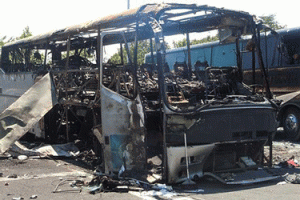 Immediately after the terror bombing of a busload of Israeli youth in Burgas, Bulgaria, both Israeli Prime Minister Benjamin Netanyahu and a “senior U.S. official” expressed certainty about Iran’s responsibility. Since then, the White House has backed away from that position, after Bulgarian investigators warned against that assumption before the investigation is complete.
Immediately after the terror bombing of a busload of Israeli youth in Burgas, Bulgaria, both Israeli Prime Minister Benjamin Netanyahu and a “senior U.S. official” expressed certainty about Iran’s responsibility. Since then, the White House has backed away from that position, after Bulgarian investigators warned against that assumption before the investigation is complete.
Similary, it is generally assumed that Iran and Hezbollah were responsible for the terrorist bombing of a Jewish community center in Buenos Aires on July 18, 1994, because US and Israeli officials, journalists and commentators have repeated that conclusion so often. It was the first reference made by those who were most eager to blame the Burgas bombing on Iran, such as Matthew Levitt and Jeffrey Goldberg.
But that terrorist bombing 18 years ago was not what it has come to appear by the constant drip of unsubstantiated journalistic and political references to it. The identification of that bombing as an Iranian operation should be regarded as a cautionary tale about the consequences of politics determining the results of a terrorist investigation.
The case made by the Argentine prosecutors that Iran and Hezbollah committed that 1994 terrorist bombing has long been cited as evidence that Iran is the world’s premier terrorist state.
But the Argentine case was fraudulent in its origins and produced a trail of false evidence in service of a frame-up. There is every reason to believe that the entire Argentine investigation was essentially a cover-up that protected the real perpetrators.
That is what I learned from my ten-month investigation in 2006-07 of the case, the results of which were published in early 2008.
William Brencick, who was then chief of the political section at the US Embassy in Buenos Aires and the primary Embassy contact for the investigation of the AMIA bombing, told me in an interview in June 2007 that the US conviction about Iranian culpability was based on what he called a “wall of assumptions” — a wall that obstructed an objective analysis of the case. The first assumption was that it was a suicide bombing, and that such an operation pointed to Hezbollah, and therefore Iran.
But the evidence produced to support that assumption was highly suspect. Of 200 initial eyewitnesses to the bombing, only one claimed to have seen the white Renault van that was supposed to have been the suicide car. And the testimony of that lone witness was contradicted by her sister, who said that she had seen only a black and yellow taxicab.
That is only the first of many indications that the official version of how the bombing went down was a tissue of lies. For example:
- – The US explosives expert sent soon after the bombing to analyze the crime scene found evidence suggesting that at least some of the explosives had been placed inside the community center, not in a car outside.
- – The engine block of the alleged suicide car which Police said led them to the arrest of the Shi’a used car salesman and chop shop owner who sold the car, was supposedly found in the rubble with its identification number clearly visible — something any serious bombing team, including Hezbollah, would have erased, unless it was intentionally left to lead to the desired result.
- – Representatives of the Menem government twice offered large bribes to the used car dealer in custody to get him to finger others, including three police officials linked to a political rival of Menem. The judge whose bribe was videotaped and shown on Argentine television was eventually impeached.
Apart from an Argentine investigation that led down a false trail, there were serious problems with the motives attributed to Iran and Hezbollah for killing large numbers of Jewish citizens of Argentina. The official explanation was that Iran was taking revenge on the Menem government for having reneged, under pressure from the Clinton administration, on its agreements with Iran on nuclear cooperation.
But in fact, Argentina had only halted two of the three agreements reached in 1987 and 1988, as was revealed, ironically, in documents cited by the Argentine prosecutor’s report on the arrest warrant for Iranian officials dated October 2006 (unfortunately never made available in electronic form). The documents showed that the Menem government was continuing to send 20 percent enriched uranium to Iran under the third agreement, and there were negotiations continuing both before and after the bombing to resume full nuclear cooperation.
As for Hezbollah, it was generally assumed that it wanted to avenge the Israeli killing of its “ally” Mustafa Dirani in May 1994. But when Hezbollah really wanted to take revenge against Israel, as it did after the Israeli massacre in Qana in 1996, it did not target civilians in a distant country with no relationship to the conflict with Israel; it openly attacked Israel with Katyusha rockets.
It is not clear yet who committed the latest terrorist bombing against Jewish civilians in Burgas, Bulgaria. But the sorry history of that Buenos Aires investigation should not be used to draw a premature conclusion about this matter or any other terrorist action.






In light of the concerted attempt by Israeli officials and the Jewish state’s partisans to link Burgas to Buenos Aires, it’s worth recalling Alireza Miryousefi’s reply to Alan Dershowitz published by the Wall Street Journal this February. As the First Secretary of the Mission of the Islamic Republic of Iran to the U.N. observed about an earlier attack in the Argentine capital:
“Finally, regarding the author’s false allegations about Iran’s role in a bombing in Argentina in 1992, suffice it to say that the real target was Argentina’s bilateral relations with Iran. Given Israel’s notoriety in using so-called ‘false flag operations,’ the real value of Mr. Dershowitz’s article is that it should send a warning to the people and American policy makers to beware of not falling into yet another Israeli trap.”
When investigating tragic events such as the 1994 bombing of the Jewish Community Center in Buenos Aires, Argentina and the most recent attack on a busload of Israeli tourists in Burgas, Bulgaria, those involved in the investigations must answer one simple, yet vital question: Qui bono? Who benefits? By answering this question, the Bulgarian invesigators will be able to point their fingers in the right direction – directly at Israel and its Prime Minister, Benjamin Netanyahu.
Netanyahu and his Defense Minister, Ehud Barak, are chomping at the bit to attack Iran; so, why not use the Burgas tragedy as a casus belli for this attack. Israel is notorious for “false flag” attacks; former Mossad agent Victor Ostrovsky has described the agency’s modus operandi in his book “By Way of Deception”. This is how Israel operates, pure and simple.
Agree with Maidhc Ó Cathail especially after just watching interview with Annie Machon about the the 1994 false flag bombing of Israeli Embassy in London.
http://www.youtube.com/watch?feature=player_embedded&v=2PgQr6uYF00
I am glad to see someone casting doubt on the alleged Iranian/Hizbollahi responsibility for the AMIA bombing.
It always struck me that the accusation was being pointed that way to suit external policies and interests, and the supposed motive was thought up to try and make sense of it afterwards.
Argentina was never short of violently antsemitic elements and indeed accounts of the junta’s ‘dirty war’ on the Left make clear that Jews were singled out disproportionately for “disappearance” and torture. This incidentally did not prevent the junta benefitting from Israeli arms supplies and intelligence co-operation.
With the return to democracy these ulta-Right elements did not simply go away. Indeed they may have been given a more pressing need to assert their hand in terror, both against those seeking justice and against the Menem government’s authorisation of an investigation into “Nazi Gold” in Argentina.
I did hear rumours that important documents which might be used by investigators were housed in the AMIA building. Even if not true, those who feared where either investigation might lead -of the Nazi role or the junta’s crimes – could have believed it. Or they could have simply decided to strike a murderous blow against Argentine Jews by way of revenge-in-advance and to tell the Menem government how far it could go.
Having an alleged Iranian connection provide a ‘false flag’, even if it meant manipulating an unwitting intelligence sub-contractor, might have suited those really behind the bombing. It also suited US and Israeli interests.
By way of a footnote, an Iranian defector to the ‘States did assert that his government had been behind the bombings and reportedly claimed that London would be next. But British police made no effort to interview this man, being content to hold two Palestinians with no Iranian or Hezbollahi connections for the Israeli embassy bombing and not following up the further bombing in north London. A lot of people believed the two Palestinians were set up and that the police and security services were not looking for the real culprits. Former MI5 agents have alleged that the agency knew about the embassy bombing in advance and suggested an inside job.
Whatever the truth, the two young Palestinians were released a few years ago but on condition they kept silent, and are back in Lebanon. Nobody has come up with an Iranian “explanation” for the London bombings, but perhaps they will in time.